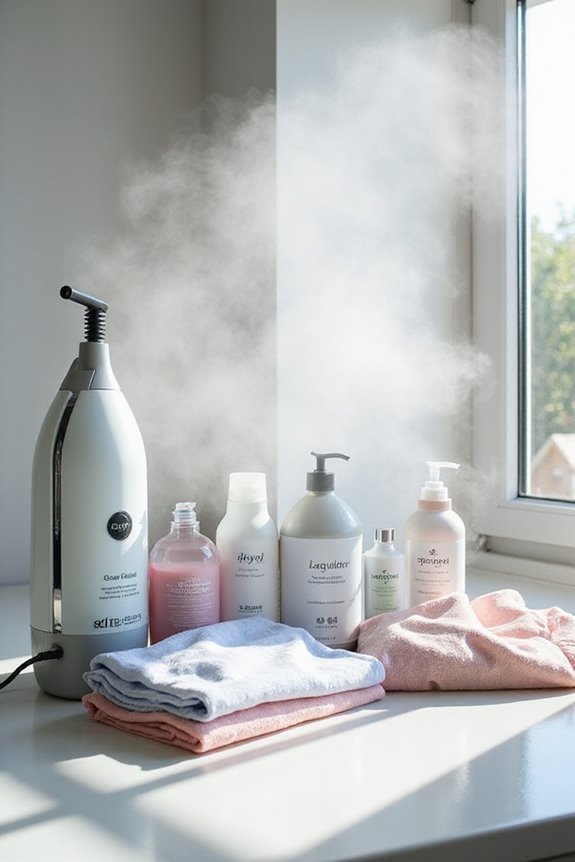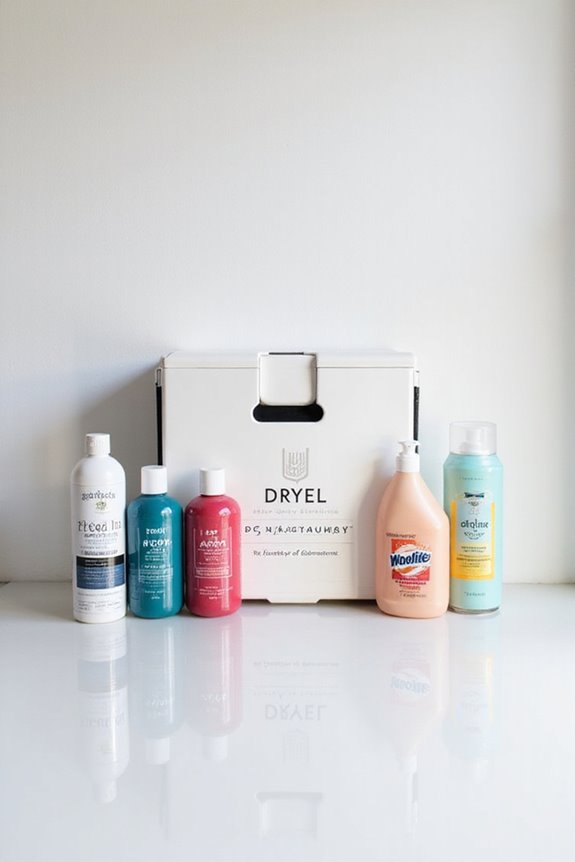When we’re done with Dryel kits, it’s key to dispose of their parts properly. For stain remover solutions, pour them down the drain with running water; just don’t do it all at once. Used dryer activated cloths go in the trash, since they’re not recyclable. As for the polyester bags, check if they’re pure polyester for recycling. Make sure to clean ’em first! Let’s be responsible together—there’s more to learn about eco-friendly disposal methods!
Key Takeaways
- Dispose of stain remover solutions by pouring down the drain slowly with running water, following specific product label instructions.
- Seal used dryer activated cloths in a bag to limit chemical exposure and dispose of them in regular trash; they are not recyclable.
- Check polyester fabric bags for recycling options; clean them before disposal to ensure they are suitable for recycling.
- Practice spill management by using dry sand or vermiculite to absorb spills and dispose of used absorbents in sealed containers.
- Keep records of disposal methods for three years to ensure compliance with local waste disposal laws and promote responsible practices.
Understanding the Components of Dryel Kits
When we talk about Dryel kits, it’s like unwrapping a little gift for your laundry! Let’s explore the component breakdown. Each kit usually includes a stain removal solution that’s perfect for tackling pesky stains. We also get absorbent pads to soak up any dirt, plus dryer activated cloths that work their magic with heat. Don’t forget the handy polyester fabric bag that keeps our clothes organized during the cleaning cycle. For usage instructions, it’s simple: treat stains with the solution, use the pads for extra help, and toss everything, including the dryer cloths, into the dryer. Different kits offer various cloth packet counts, so we can choose what fits our laundry needs best! Happy cleaning!
Safe Disposal of Stain Remover Solutions
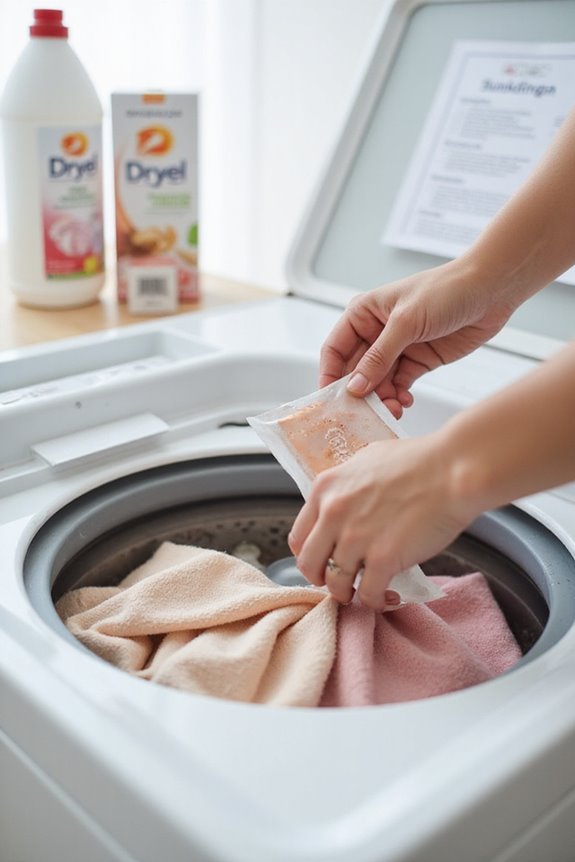
Now that we’ve got a solid understanding of the components in our Dryel kits, it’s time to tackle the all-important topic of safely disposing of our used stain remover solutions. Most of these solutions are water-soluble, so we can often pour them down the drain with running water. But let’s not go dumping large amounts all at once—slow and steady wins the race! We should always read the product label for any specific disposal methods. If we have concentrated or strong-smelling solutions left, it’s best to seal them in their original container until we can properly dispose of them. And remember, no mixing chemicals! Keeping our stain remover safety in mind helps protect both us and the environment. Additionally, choosing products with biodegradable options ensures that we are being environmentally conscious even after disposal.
Handling Used Dryer Activated Cloths
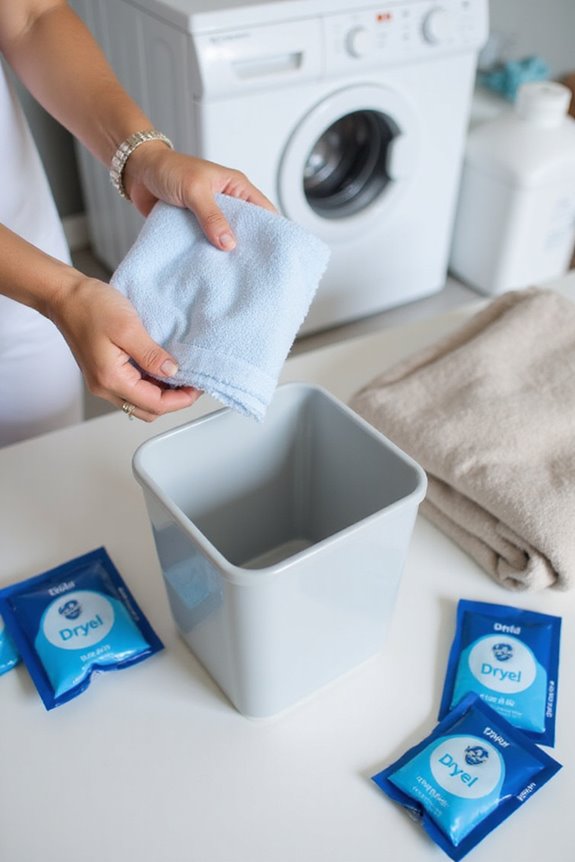
Although handling used dryer-activated cloths might seem straightforward, there are a few important details we should keep in mind. These cloths contain chemicals that can cause mild skin irritation, so it’s best to take some handling precautions. Let’s avoid vigorous shaking, as it can aerosolize lint and chemicals, which isn’t great for our health. When we’re ready to dispose of them, sealing highly soiled cloths in a bag helps limit chemical exposure and contain any mess. Remember, these cloths aren’t recyclable, so they belong in the regular trash. And, no flushing, please! We don’t want to cause plumbing issues. After handling, let’s wash our hands to remove any residual chemicals. Keeping safety first makes the process easier!
Disposing of Polyester Fabric Bags
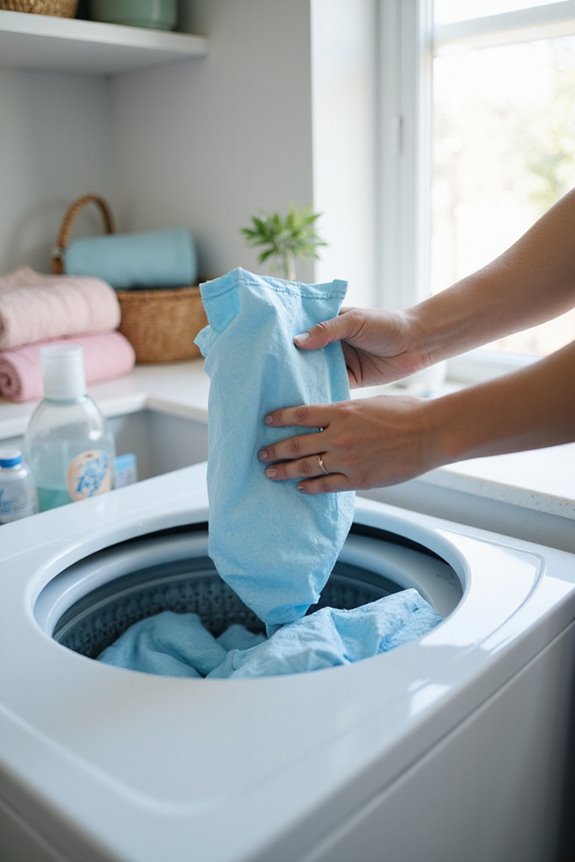
Disposing of used polyester fabric bags can feel a bit tricky, but it doesn’t have to be! First, let’s check the labels. We want to identify pure polyester from blends or coated fabrics, as this makes recycling easier. Cleaning the bags is also essential—no one wants to send dirty bags to recycling!
Once sorted, we should look for dedicated textile recycling drop-off points. Some brands even partner with recycling companies to repurpose these bags into new items. If local options are scarce, we can separate them for mechanical recycling at municipal facilities. With polyester recycling methods improving, we have eco-friendly alternatives that help reduce waste and protect our planet. Let’s make recycling our polyester bags a priority!
Environmental Precautions to Consider
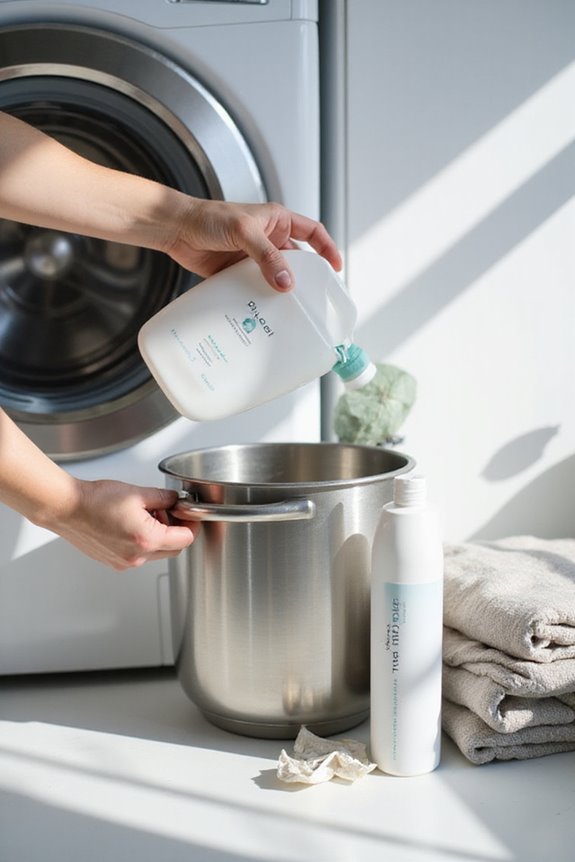
When it comes to using Dryel kits, we need to think about how our actions can impact the environment. While Dryel’s stain removal solutions are generally safe, we should still practice sustainable practices. If we spill any solution, let’s absorb it with dry sand or vermiculite and dispose of it properly. We don’t want any residues ending up in our waterways, right?
Also, remember to store our kits safely to prevent leaks. Opting for eco-friendly alternatives when possible can further reduce our environmental footprint. We’re already minimizing plastic waste with those reusable bags! By being mindful of our disposal methods, we’re not just cleaning our clothes, but also caring for our planet. Let’s keep our cleaning habits green! Additionally, choosing products made from biodegradable ingredients can enhance our commitment to environmental sustainability.
Small Household Quantity Disposal Practices
Taking care of our planet is important, and it’s just as essential to know how to properly dispose of our used Dryel kits. The best practices are pretty straightforward. We can toss used cleaning sheets, absorbent pads, and even the fabric bag into our regular household trash. For any spills, let’s remember to wipe them up with a cloth or paper towel—no pouring anything down the drain! When it comes to the empty stain remover bottle, we should rinse it out and check if our local recycling program accepts it. If not, it goes in the trash too. Always check local regulations for specific disposal tips, but generally, these materials aren’t hazardous, making disposal easy as pie!
Guidelines for Handling and Storage
To keep our Dryel kits in top shape, we should pay attention to how we handle and store them. First, let’s find a cool, dry place for safe storage. This helps maintain the cleaning agents’ strength. We need to avoid direct sunlight too, as it can degrade the solutions. When handling used cloths, it’s best to use clean, dry hands or gloves to avoid any skin irritation. Let’s also be careful not to crush the packets. They’re biodegradable but still contain residual chemicals. Finally, storing them away from food and kids is a smart move. By following these handling precautions, we can guarantee our Dryel kits stay effective and safe for future use.
Waste Containment for Spills
Spills happen, and knowing how to contain them is essential for keeping our spaces safe and tidy. When dealing with Dryel kits, we need to use proper spill containment practices. For any liquid spills, we should have absorbent materials like vermiculite or dry sand on hand to quickly soak up the mess. It’s vital that these materials are non-reactive with the chemicals in Dryel. We can also use disposable cloths for smaller spills to avoid spreading contamination. Once we clean up, let’s make sure to collect used absorbents in sealed, leak-proof containers. This way, we can dispose of everything safely and keep our environment clean. Remember, a little preparation goes a long way in preventing bigger headaches down the line!
Spill Management Techniques
When an accident happens, knowing how to handle it can save us a lot of trouble later on. First, we need to assess the spill type and volume immediately. This helps us decide on our spill response. Establishing a safe perimeter is vital, so let’s avoid walking through the mess. With appropriate PPE like gloves and goggles, we can engage in containment. Using absorbent socks or mats, we can dike the spill and prevent it from spreading. Remember, it’s about controlling the flow and making recovery easier. Once contained, we should absorb the substance and clean up carefully. And don’t forget—dispose of all used materials properly! Our safety is key, and a little preparation goes a long way!
Local Regulations and Compliance
Understanding local regulations and compliance for disposing of used Dryel kits is essential, especially since these kits can contain hazardous materials. We must be aware that many used Dryel kits, especially those with perchloroethylene, are classified as hazardous waste. That means we can’t just toss them in the trash. We need to follow specific compliance measures, like using licensed hazardous waste haulers for proper disposal. In some places, like Santa Cruz County, we’re even required to keep records for three years! It may seem tedious, but it helps prevent environmental damage and avoids fines. So, let’s stay informed and guarantee we’re not the ones accidentally causing a mess with our laundry habits!
Frequently Asked Questions
Can I Reuse the Dryer Activated Cloths After Washing Them?
We can’t reuse the dryer activated cloths after washing them. Doing so compromises Dryel effectiveness, as the cleaning agents are heat-activated and lost in water. Let’s always follow the instructions for ideal results.
What Should I Do if I Accidentally Ingest Dryel Solution?
If we accidentally ingest Dryel solution, we should prioritize safety precautions. Let’s rinse our mouths, drink water, and seek emergency response from poison control right away to guarantee proper care and avoid complications.
Are There Any Specific Disposal Requirements for Larger Quantities?
When it comes to larger quantities, we must follow strict disposal regulations. These materials can be classified as hazardous waste, so proper containment and disposal through licensed services are vital to guarantee safety and compliance.
Can I Compost Biodegradable Components of Dryel Kits?
While some components claim biodegradable benefits, we shouldn’t compost them without following proper composting guidelines. Most physical parts, like cloths and synthetic materials, aren’t suitable for composting, so disposal in trash is recommended.
How Long Can I Store Unused Dryel Products Before Disposal?
Let’s say we found an old Dryel kit in our closet. We should follow expiration guidelines and use it within 1-2 years, adhering to storage recommendations for maximum effectiveness and longevity.


